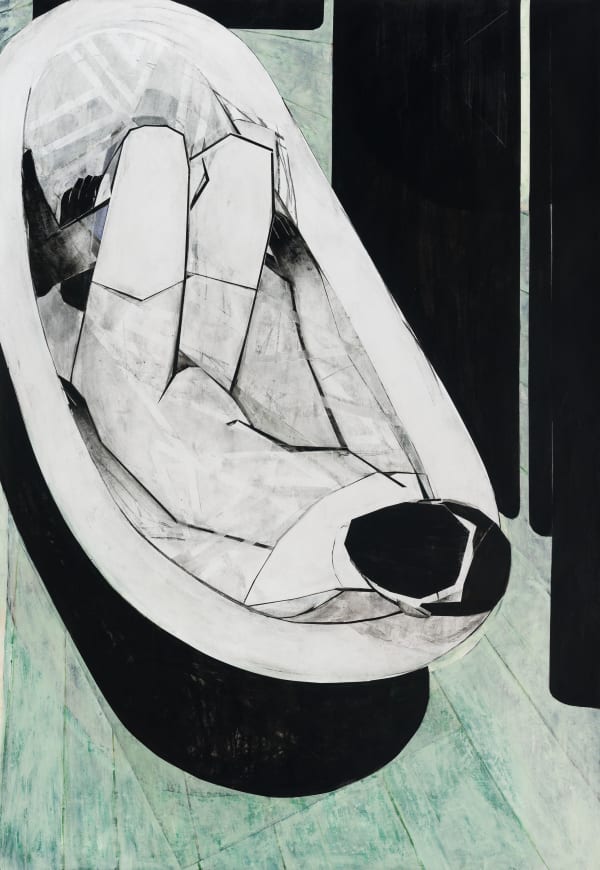OBLIVION: IRIS SCHOMAKER
-
Introduction
In the new exhibition Oblivion by Iris Schomaker at Galerie Thomas Schulte, the artist presents her most recent series of works on paper. Her unframed large-scale works depict landscapes, figures, and animals. The motifs serve to reproduce a specific atmosphere, for which Schomaker has developed her very own formal and pictorial language. It shows the possibilities of painting to illustrate an emotional state, making it visually perceptible so that the paintings resonate with the subjective memories of the viewer. Although her works remain true to figuration, Schomaker consistently develops her characteristic abstract painting style.
Employing her signature minimalist color palate, the artist drapes her figures in predominantly black oil or watercolor paint. Brighter colors, such as green, orange, and blue are used selectively to accentuate the figures’ clothing and accessories, the floor tiles of the interior spaces they inhabit, and the vegetation of the landscapes in the backdrop. Formal simplifications and traces of the drawing process left in the paintings give the works a graphic, open quality. An openness that makes visible the pathways and artistic questions which lead to the final work. This approach is essential to the composition of the images. At the same time, the use of monochrome surfaces and geometric shapes push us to concentrate on the creative moment. In the upcoming exhibition, Schomaker presents her larger-than-life motifs on individual sheets of paper, which are attached directly to the wall with a clamp and without a frame. In this way, the works engage in constant dialogue with the other works, while creating a sense of visual and physical intimacy with the viewer.
The images themselves are intimate as well: inviting the viewer in to consider individuals as they inhabit silent, pensive, and solitary positions. A small portrait captures a figure’s profile from the shoulder upwards. She lies backwards in the water, her ears submerged below the surface, her eyes closed. Strands of hair float in the dark water that seems to cradle her body, bringing the mind to rest. In this work, rhythmic, crystalline structures fuse to create a weightless, suspended spatial environment. The painting’s title Undine pays homage to the female water spirit depicted in legends of the Middle Ages. A strong, semi-divine being who, like water, floats in ambivalence. Water—in its physical and symbolic properties—has long since been a core theme in Schomaker’s work, bringing meaning to many of her images. In its versatility and universality, Schomaker has played with themes of water to explore the form of human swimmers and the mythological habitats of mermaids. Water also figures in her depictions of private moments, such as bath and shower scenes. Rich in energy and mutable in form, water provides us with spaces of reflection. Allowing at once for a sense of clarity and the blurring of fixity and fluidity. Transparency, thus, relies on stillness.
Despite its clarity, water also veils. It was this theme that Schomaker began incorporating in her work early on. Cloaking the faces of her subjects in varying degrees of legibility, Schomaker applies coats of paint to their faces, layer by layer, as if shrouding them with a veil, wetting them with beads of water-under the rain, the shower, or their tears. In this way, Schomaker’s painted faces often become open surfaces upon which she invites us to project our imagination. While many of her works create intimacy between subject and viewer, a small number of pieces, by contrast, seem to reinforce a palpable distance. In these works, the figures wear black sharp-edged masks over their faces, which erase any personal features and thus allow for free associations.
In some works, figures are accompanied by animals such as foxes or cats. Detached from time and space, the beings engender moments of realization and strength. Powerful and calm, their presence encapsulates an existential state, whereby their juxtaposition to human subjects allows them to embody spiritual and soul-mate-like positions. Animal and human thus stand in symbiotic and harmonious relationship to each other. A harmony in the inner world, which brings clarity to the outer world.
-
Works
-
Installation Views
-
INQUIRE ABOUT WORKS BY Iris Schomaker

-
Video
-
Artists on view









